|
January 18, 2008
To the little known weaving centers of Barhampur, Pittal and Boirani
Barhampur
The main production area for Orissa sarees is around Sambhalpur in the north, but there are also some smaller areas of production mid state and in around Barhampur. Mr. Lenka, my trusted associate here in Orissa handed me a beautiful book of traditional sari designs that I'd never seen before. It got me very excited to see the huge design range that used to be produced in the state. Barhampur is a five hour drive south of Bhubaneshwar and has a reputation for silk sari production. I thought I'd start there to learn more.
I entrusted my guidance to a local who specializes in Orissa tribal tours. Mithu, while not knowing Jack about sarees is a friendly, quiet fellow who knows the state well, so after a few phone calls he was able to sleuth out some more production areas near Barhampur. We left at 5:30am, after we were out of the coastal fog and on the "highway" Mithu announced that he has an uncle in Barhampur and asked would I like to stop there for a chai. A real uncle? I asked. "Yes, Father Brother." All uncles are not alike in India.
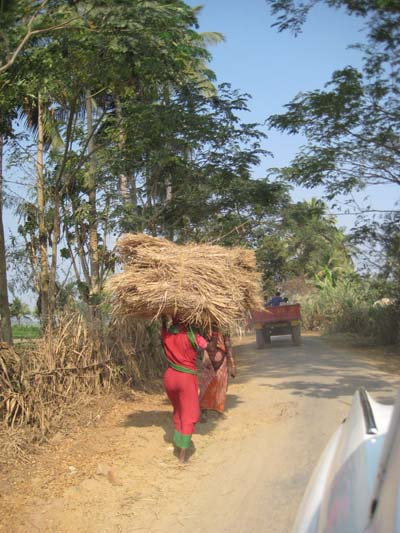 The highway was very good in places and it was fun to only be going 50 km per hour in the Ambassador, so much like a sofa on wheels. The landscape was superb, fields and lots of ponds, gigantic cashew and mango trees. Boulder strewn hillsides off in the distance beckoned. The rice harvest was in and villagers were stacking the chaff they'd separated into huge hut sized mounds, others were filling sacks of grain. We passed hundreds of madly decorated trucks, sporting flowers, deities, wise sayings and all kinds of tinsel and pieces of cloth. These dainty flourishes only seemed to accent their bulk. The highway was very good in places and it was fun to only be going 50 km per hour in the Ambassador, so much like a sofa on wheels. The landscape was superb, fields and lots of ponds, gigantic cashew and mango trees. Boulder strewn hillsides off in the distance beckoned. The rice harvest was in and villagers were stacking the chaff they'd separated into huge hut sized mounds, others were filling sacks of grain. We passed hundreds of madly decorated trucks, sporting flowers, deities, wise sayings and all kinds of tinsel and pieces of cloth. These dainty flourishes only seemed to accent their bulk.
This is the National Highway to Chennai and in many spots is still under construction or on a detour through the center of small towns where the divided highway ends. Every few kilometers we'd get in a jam as we went through the different settlements with their street stalls encroaching into the road and slowing things down. The road was in certain places barely passable and the driver had to navigate through huge holes, sandy patches and pavement level changes.
Mithu's sweet Auntie served us chai in her second floor flat on the outskirts of the city. I said I like her place and Mithu asked if I'd like to stay the night there instead of a hotel and I said okay - if they really want. I displaced their two sons who slept on the concrete floor of the living room. Looking back on a sleepless night in an incredibly squeaky bed on a compacted bumpy mattress I should have opted for my own room.
We went into Barhampur after chai and drove to a district with a street of weavers. Barhampur was once a busy production area for silks, but the market is not so great now and production is down. The book Mr. Lenka gave me had showed many of examples of original bomkai sarees made in Barhampur and I got excited to think that maybe I'd get lucky and find some in the market there. We threaded our way slowly through the narrow congested lanes lined by dusty stores and shanty shops. Asking a few people as we neared it we could find our way to a street of weavers. There was no sign of weavers, but then I recognized the warping racks on the steps of some houses.
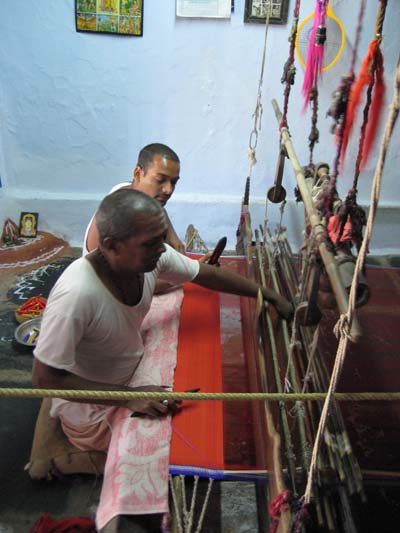 At one house we stood looking at some warp bundles on the veranda and were asked in and we sat transfixed for an hour watching the work. The weaver and his wife sat at the loom. They were weaving silk on a pit loom, the warp threads strung over the concrete floor. A beautiful design was painted on the floor and rendered the room like a temple. A small shrine, oft anointed, stood in the corner with his spools of silk soaking in a bowl of starch water in front of it. At one house we stood looking at some warp bundles on the veranda and were asked in and we sat transfixed for an hour watching the work. The weaver and his wife sat at the loom. They were weaving silk on a pit loom, the warp threads strung over the concrete floor. A beautiful design was painted on the floor and rendered the room like a temple. A small shrine, oft anointed, stood in the corner with his spools of silk soaking in a bowl of starch water in front of it.
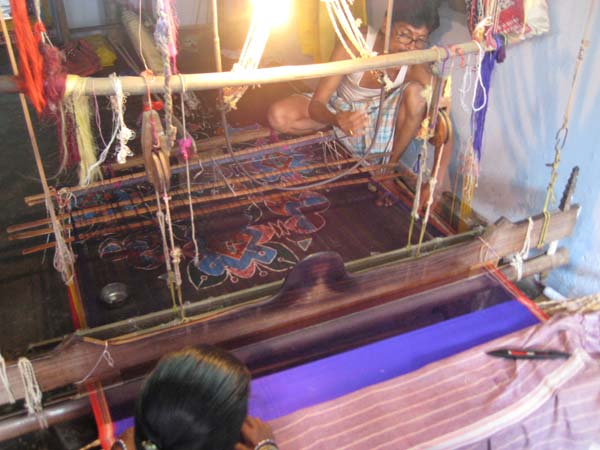
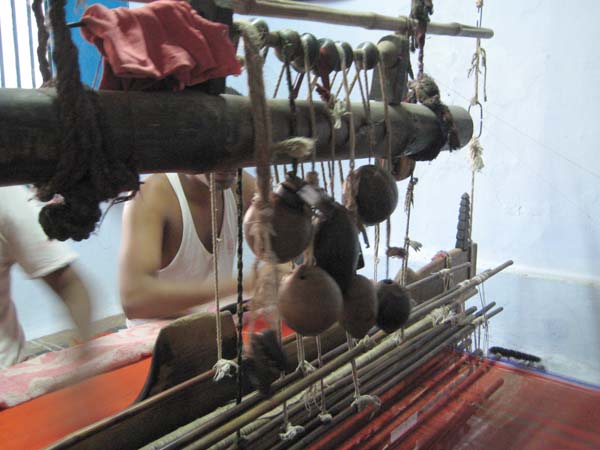 They sat at loom that is so completely hand tooled - more ingenuity than material, added to over the generations, retooled for new uses again and again. There's not much to hand weaving that isn't a stick or a bit of thread and it is always moving to see how simple things can render such complex ones. They sat at loom that is so completely hand tooled - more ingenuity than material, added to over the generations, retooled for new uses again and again. There's not much to hand weaving that isn't a stick or a bit of thread and it is always moving to see how simple things can render such complex ones.
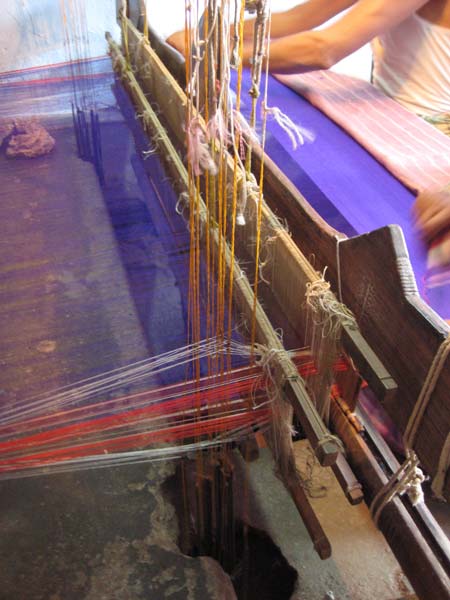 Narrow design bands of rudraksa beads or fish can be made with a minimum of pattern repeats so simple string heddles can do the job. Weighted eyes are tied together for each row of the pattern, then they are threaded over the top of the loom and serviced by a sequence of rings that are pulled down tight over a circular wire. He slips them tight ring by ring and back to make the pattern. A neighbor of this weaver had a stair step U form wire on his loom. Another had metal hooks that got hung on a stationary piece of bamboo. Narrow design bands of rudraksa beads or fish can be made with a minimum of pattern repeats so simple string heddles can do the job. Weighted eyes are tied together for each row of the pattern, then they are threaded over the top of the loom and serviced by a sequence of rings that are pulled down tight over a circular wire. He slips them tight ring by ring and back to make the pattern. A neighbor of this weaver had a stair step U form wire on his loom. Another had metal hooks that got hung on a stationary piece of bamboo.
For the bhutta separate heddles of string on a wire or bamboo frame lifted the threads for patterning. The bhutta threads were put in at intervals from small spools of contrasting thread. We sat there for an hour on the floor of the house - it's hard to leave these weavers. The motion of the loom makes a beautiful sound. There is the regular clacking of bamboo and the chiming of metal rings with each shed accompanied the whizzing sound of the shuttle being thrown across the warp. Hearing these sounds one gets transported back in time - this has been going on for centuries here. The regular motion and peacefulness of their demeanor puts you in a trance.
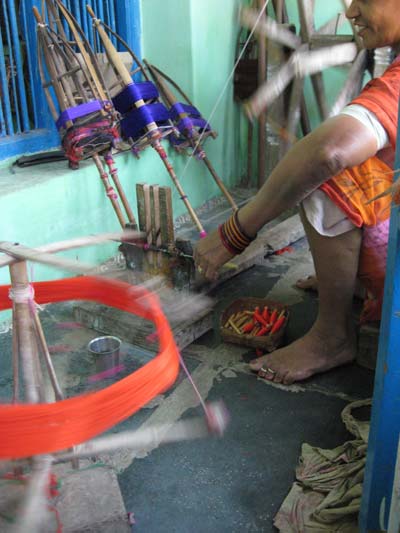 Sari production require many hands for the patient winding and organizing of thousands of thread ends every day. Sari production require many hands for the patient winding and organizing of thousands of thread ends every day.
After the visit to the weavers we took a hopeful stroll through the local textile market, but as I suspected there was little to be found in the way of cotton handlooms. Small town tastes are all about flashy fashion and unfortunately polyester mill sarees.
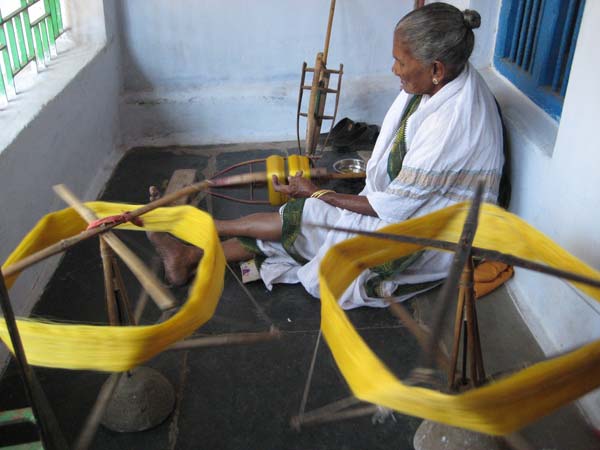
Pittal
The next morning we left Barhampur about 7am and arrived in Pittal 30 km to the northwest still in the morning coolness. Asking around Mithu was able to direct the taxi to a lane where the weavers live and work. They were easy to spot as the narrow sandy track was alive with activity. Warp after warp was being stretched out down the whole lane and the clickety clack, ching ching of looms could be heard coming from many of the houses.
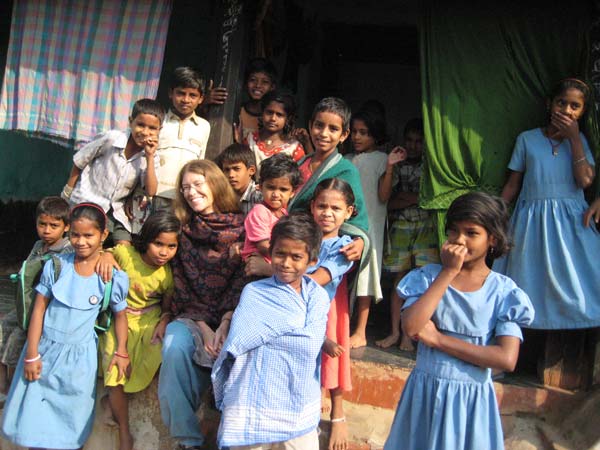 Word that there was a foreign visitor spread around and in minutes everyone was out on their steps. Bands of children came for a closer look. Giggling and pointing they nudged each other every time I made a funny face or smiled at some shyer one. Unlike many other places I've been in India - all faces in Pittal gave way to a smile eventually. Word that there was a foreign visitor spread around and in minutes everyone was out on their steps. Bands of children came for a closer look. Giggling and pointing they nudged each other every time I made a funny face or smiled at some shyer one. Unlike many other places I've been in India - all faces in Pittal gave way to a smile eventually.
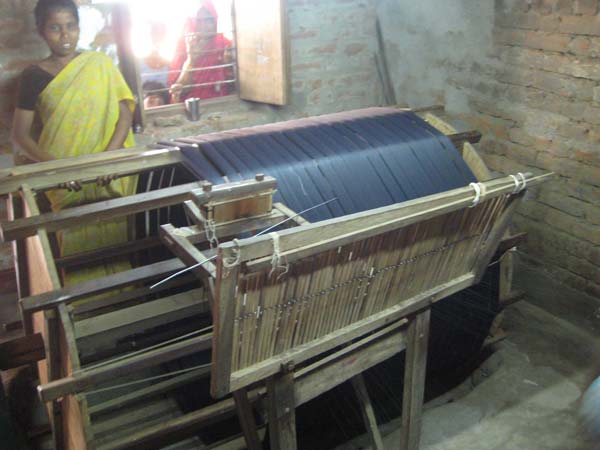 In one of the houses we were invited to watch two young women measure off the warp threads. A huge rotating drum made of wood took up the lengths of warp threads. It rotated in a pit, its axle on two short posts set into the floor. Opposite the drum was a rack of many cones of thread and a matrix of eyes. One woman rotates the drum while the other manages the off spooling of threads. The cotton threads are so incredibly fine that they sometimes break or twist into themselves, or a cone will run out and the ends must be tied. The threads are fed through a set of bamboo eyes and combs and form two groups of threads winding around the drum. These are tied off separately and used for the cross of warp that will be later put onto the loom. In one of the houses we were invited to watch two young women measure off the warp threads. A huge rotating drum made of wood took up the lengths of warp threads. It rotated in a pit, its axle on two short posts set into the floor. Opposite the drum was a rack of many cones of thread and a matrix of eyes. One woman rotates the drum while the other manages the off spooling of threads. The cotton threads are so incredibly fine that they sometimes break or twist into themselves, or a cone will run out and the ends must be tied. The threads are fed through a set of bamboo eyes and combs and form two groups of threads winding around the drum. These are tied off separately and used for the cross of warp that will be later put onto the loom.
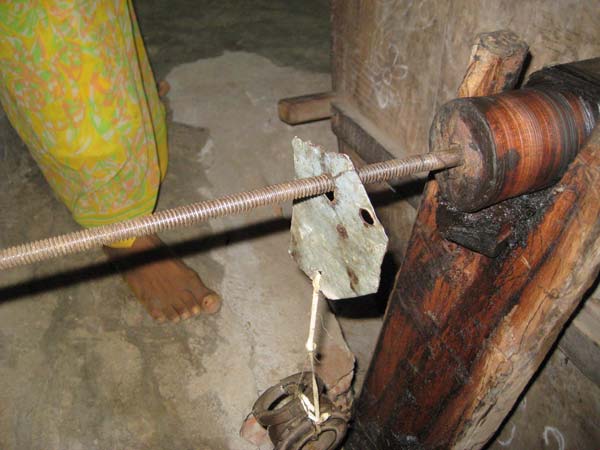 The drum was spun by hand, very fast and the woman was winded after a length was finished. I asked them how they know when to stop spinning, how can they tell what the length is. They pointed to the side of the drum. Squeezing around the back of the drum I saw an ingenious solution. A length of threaded rod extending out from the axle determines how many spins of the drum. A disc of thin plate with a circle cut out of the center and weighted with any number of heavy metal odds and ends is set onto the threaded rod at the axle. When the drum rotates, the weighted plate is moved along the rod on the grooves away from the drum. When it drops off they stop the drum and tie off that set of threads. The drum was spun by hand, very fast and the woman was winded after a length was finished. I asked them how they know when to stop spinning, how can they tell what the length is. They pointed to the side of the drum. Squeezing around the back of the drum I saw an ingenious solution. A length of threaded rod extending out from the axle determines how many spins of the drum. A disc of thin plate with a circle cut out of the center and weighted with any number of heavy metal odds and ends is set onto the threaded rod at the axle. When the drum rotates, the weighted plate is moved along the rod on the grooves away from the drum. When it drops off they stop the drum and tie off that set of threads.
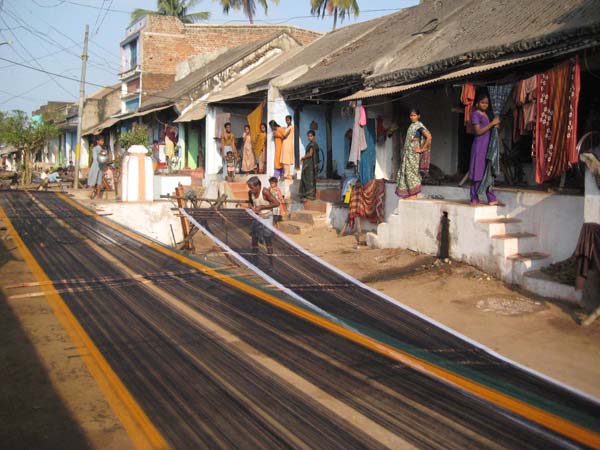 On the lane outside they were busy laying out the warps. Portable warping racks are anchored to the ground 15 meters apart. Thicker rods anchored to the rack hold the warp, which is slipped on painstakingly bunch by bunch. The warp is doubled, starting at one end, spanning to the other and then wrapping around and back to the first. This length of warp is 5 sarees, or 30 meters. The cross is kept and propagated at many spots along the length with bamboo lease sticks which are used to spread the warp threads out evenly over the 20 meters of stretched out warp. These bamboo sticks will be wound up with the warp on the loom and help to maintain the spacing of the threads during weaving. Starch is applied to the warp threads at the end to help in sleying and threading the loom. They use a wide handmade brush for this and I saw one weaver doing a small puja to his brush before he began. On the lane outside they were busy laying out the warps. Portable warping racks are anchored to the ground 15 meters apart. Thicker rods anchored to the rack hold the warp, which is slipped on painstakingly bunch by bunch. The warp is doubled, starting at one end, spanning to the other and then wrapping around and back to the first. This length of warp is 5 sarees, or 30 meters. The cross is kept and propagated at many spots along the length with bamboo lease sticks which are used to spread the warp threads out evenly over the 20 meters of stretched out warp. These bamboo sticks will be wound up with the warp on the loom and help to maintain the spacing of the threads during weaving. Starch is applied to the warp threads at the end to help in sleying and threading the loom. They use a wide handmade brush for this and I saw one weaver doing a small puja to his brush before he began.
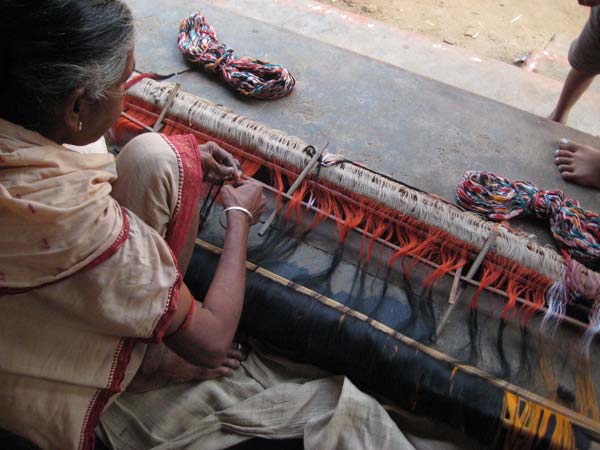 On the front stoops of the houses many older women sat tying a new warp onto an old one. The heddles and reed are taken off the loom with the waste warp of the previous sarees still threaded through them. Tying these to the ends of the new warp it is just a matter of pulling the new warp through. On the front stoops of the houses many older women sat tying a new warp onto an old one. The heddles and reed are taken off the loom with the waste warp of the previous sarees still threaded through them. Tying these to the ends of the new warp it is just a matter of pulling the new warp through.
The weavers of this village were all working on low cost sarees with plain field and ikat border and pallu design called "das phulia". Pre-dyed ikat warp and weft designs were brought from Sambhalpur as well as the designs. Apparently no one in Pittal is still doing any ikat dying. The looms in Pittal were specifically set up for ikat patterning and were all outfitted with flying shuttles. The weaving went by very fast - a sari can be made in a day.
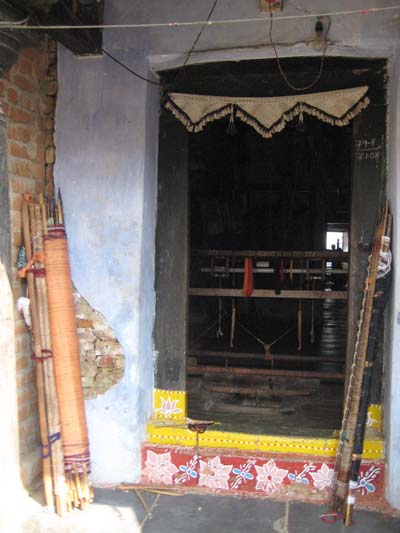 What strikes me most about village production is the sheer ingenuity of the people. Each loom was built by the family elders, fathers and grandfathers of the present day masters. The looms are all hand made, no two are alike - the wooden posts and beams, bamboo sticks, weights of dried coconuts, spindles and pulleys made from bicycle parts are a testament to the weaver's inventiveness. Long years of daily use have made them heart wrenchingly beautiful, a gentle patina, not only in the gleam of oft handled wood, but in the atmosphere around a loom. A loom at rest seems to be resting. What strikes me most about village production is the sheer ingenuity of the people. Each loom was built by the family elders, fathers and grandfathers of the present day masters. The looms are all hand made, no two are alike - the wooden posts and beams, bamboo sticks, weights of dried coconuts, spindles and pulleys made from bicycle parts are a testament to the weaver's inventiveness. Long years of daily use have made them heart wrenchingly beautiful, a gentle patina, not only in the gleam of oft handled wood, but in the atmosphere around a loom. A loom at rest seems to be resting.
Boyrani and traditional textile heritage
The name Boyrani means weaver in the Oriya language. Driving into this small village Mithu informed me that this was his father's native place. Our chugging Ambassador insisted it's bulk through impossibly narrow and hardly navigable lanes. I kept thinking he's not going to drive up that is he? Asking about the presence of weavers in the village we got mostly negatives, but finally found a street that at least used to be a place for weavers. There was only one old man sitting at a loom. His eyesight was no longer good enough to do any fine work so he was keeping himself busy and productive in his old age weaving lunghees for the Boyrani weaving society. He receives a pittance for his work and understandably his children have never wanted to join his trade. He told us that most of the weavers of Boyrani had to give up the trade or had gone to the mills of Surat for work. They are forced to make the very cheap polyester sarees that have taken over the market. Boyrani, is no longer the place for Boyan these days.
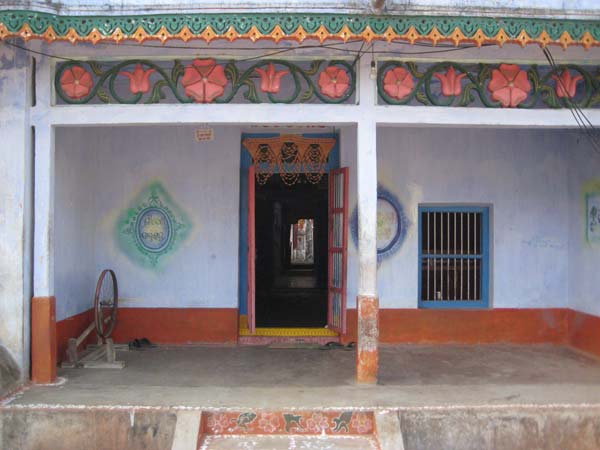
Of course we couldn't be in the village and not go visit his family, which was just celebrating the 1st birthday of a daughter. The house was set up for a special puja and offering of presents and money to the little girl who was a bit scared of all the attention and people putting flower petals on her head. A priest blew on a conch for a deafeningly long time and the women trilled their tongues, the baby clutched scared to its mommy and resisted the gifts pressed into her hand. She was given a frilly polyester dress and something that looked like an ice skating costume, full of silver sequins on shiny lime green polyester - somehow so off on a one year old. You can see how the tastes for "chamak dhamak" are developed early on, even in the eyes of villagers where the original textiles were once the preference. Demand is down - many of India's hand weavers are going extinct.
Read more about Orissa ikat textiles techniques here.
February 26, 2009 Sarisafari visits the Natural dyers of Kotpad
All images and text © Sarisafari
|






 The highway was very good in places and it was fun to only be going 50 km per hour in the Ambassador, so much like a sofa on wheels. The landscape was superb, fields and lots of ponds, gigantic cashew and mango trees. Boulder strewn hillsides off in the distance beckoned. The rice harvest was in and villagers were stacking the chaff they'd separated into huge hut sized mounds, others were filling sacks of grain. We passed hundreds of madly decorated trucks, sporting flowers, deities, wise sayings and all kinds of tinsel and pieces of cloth. These dainty flourishes only seemed to accent their bulk.
The highway was very good in places and it was fun to only be going 50 km per hour in the Ambassador, so much like a sofa on wheels. The landscape was superb, fields and lots of ponds, gigantic cashew and mango trees. Boulder strewn hillsides off in the distance beckoned. The rice harvest was in and villagers were stacking the chaff they'd separated into huge hut sized mounds, others were filling sacks of grain. We passed hundreds of madly decorated trucks, sporting flowers, deities, wise sayings and all kinds of tinsel and pieces of cloth. These dainty flourishes only seemed to accent their bulk. At one house we stood looking at some warp bundles on the veranda and were asked in and we sat transfixed for an hour watching the work. The weaver and his wife sat at the loom. They were weaving silk on a pit loom, the warp threads strung over the concrete floor. A beautiful design was painted on the floor and rendered the room like a temple. A small shrine, oft anointed, stood in the corner with his spools of silk soaking in a bowl of starch water in front of it.
At one house we stood looking at some warp bundles on the veranda and were asked in and we sat transfixed for an hour watching the work. The weaver and his wife sat at the loom. They were weaving silk on a pit loom, the warp threads strung over the concrete floor. A beautiful design was painted on the floor and rendered the room like a temple. A small shrine, oft anointed, stood in the corner with his spools of silk soaking in a bowl of starch water in front of it. They sat at loom that is so completely hand tooled - more ingenuity than material, added to over the generations, retooled for new uses again and again. There's not much to hand weaving that isn't a stick or a bit of thread and it is always moving to see how simple things can render such complex ones.
They sat at loom that is so completely hand tooled - more ingenuity than material, added to over the generations, retooled for new uses again and again. There's not much to hand weaving that isn't a stick or a bit of thread and it is always moving to see how simple things can render such complex ones. Narrow design bands of rudraksa beads or fish can be made with a minimum of pattern repeats so simple string heddles can do the job. Weighted eyes are tied together for each row of the pattern, then they are threaded over the top of the loom and serviced by a sequence of rings that are pulled down tight over a circular wire. He slips them tight ring by ring and back to make the pattern. A neighbor of this weaver had a stair step U form wire on his loom. Another had metal hooks that got hung on a stationary piece of bamboo.
Narrow design bands of rudraksa beads or fish can be made with a minimum of pattern repeats so simple string heddles can do the job. Weighted eyes are tied together for each row of the pattern, then they are threaded over the top of the loom and serviced by a sequence of rings that are pulled down tight over a circular wire. He slips them tight ring by ring and back to make the pattern. A neighbor of this weaver had a stair step U form wire on his loom. Another had metal hooks that got hung on a stationary piece of bamboo. Sari production require many hands for the patient winding and organizing of thousands of thread ends every day.
Sari production require many hands for the patient winding and organizing of thousands of thread ends every day. Word that there was a foreign visitor spread around and in minutes everyone was out on their steps. Bands of children came for a closer look. Giggling and pointing they nudged each other every time I made a funny face or smiled at some shyer one. Unlike many other places I've been in India - all faces in Pittal gave way to a smile eventually.
Word that there was a foreign visitor spread around and in minutes everyone was out on their steps. Bands of children came for a closer look. Giggling and pointing they nudged each other every time I made a funny face or smiled at some shyer one. Unlike many other places I've been in India - all faces in Pittal gave way to a smile eventually. In one of the houses we were invited to watch two young women measure off the warp threads. A huge rotating drum made of wood took up the lengths of warp threads. It rotated in a pit, its axle on two short posts set into the floor. Opposite the drum was a rack of many cones of thread and a matrix of eyes. One woman rotates the drum while the other manages the off spooling of threads. The cotton threads are so incredibly fine that they sometimes break or twist into themselves, or a cone will run out and the ends must be tied. The threads are fed through a set of bamboo eyes and combs and form two groups of threads winding around the drum. These are tied off separately and used for the cross of warp that will be later put onto the loom.
In one of the houses we were invited to watch two young women measure off the warp threads. A huge rotating drum made of wood took up the lengths of warp threads. It rotated in a pit, its axle on two short posts set into the floor. Opposite the drum was a rack of many cones of thread and a matrix of eyes. One woman rotates the drum while the other manages the off spooling of threads. The cotton threads are so incredibly fine that they sometimes break or twist into themselves, or a cone will run out and the ends must be tied. The threads are fed through a set of bamboo eyes and combs and form two groups of threads winding around the drum. These are tied off separately and used for the cross of warp that will be later put onto the loom. The drum was spun by hand, very fast and the woman was winded after a length was finished. I asked them how they know when to stop spinning, how can they tell what the length is. They pointed to the side of the drum. Squeezing around the back of the drum I saw an ingenious solution. A length of threaded rod extending out from the axle determines how many spins of the drum. A disc of thin plate with a circle cut out of the center and weighted with any number of heavy metal odds and ends is set onto the threaded rod at the axle. When the drum rotates, the weighted plate is moved along the rod on the grooves away from the drum. When it drops off they stop the drum and tie off that set of threads.
The drum was spun by hand, very fast and the woman was winded after a length was finished. I asked them how they know when to stop spinning, how can they tell what the length is. They pointed to the side of the drum. Squeezing around the back of the drum I saw an ingenious solution. A length of threaded rod extending out from the axle determines how many spins of the drum. A disc of thin plate with a circle cut out of the center and weighted with any number of heavy metal odds and ends is set onto the threaded rod at the axle. When the drum rotates, the weighted plate is moved along the rod on the grooves away from the drum. When it drops off they stop the drum and tie off that set of threads. On the lane outside they were busy laying out the warps. Portable warping racks are anchored to the ground 15 meters apart. Thicker rods anchored to the rack hold the warp, which is slipped on painstakingly bunch by bunch. The warp is doubled, starting at one end, spanning to the other and then wrapping around and back to the first. This length of warp is 5 sarees, or 30 meters. The cross is kept and propagated at many spots along the length with bamboo lease sticks which are used to spread the warp threads out evenly over the 20 meters of stretched out warp. These bamboo sticks will be wound up with the warp on the loom and help to maintain the spacing of the threads during weaving. Starch is applied to the warp threads at the end to help in sleying and threading the loom. They use a wide handmade brush for this and I saw one weaver doing a small puja to his brush before he began.
On the lane outside they were busy laying out the warps. Portable warping racks are anchored to the ground 15 meters apart. Thicker rods anchored to the rack hold the warp, which is slipped on painstakingly bunch by bunch. The warp is doubled, starting at one end, spanning to the other and then wrapping around and back to the first. This length of warp is 5 sarees, or 30 meters. The cross is kept and propagated at many spots along the length with bamboo lease sticks which are used to spread the warp threads out evenly over the 20 meters of stretched out warp. These bamboo sticks will be wound up with the warp on the loom and help to maintain the spacing of the threads during weaving. Starch is applied to the warp threads at the end to help in sleying and threading the loom. They use a wide handmade brush for this and I saw one weaver doing a small puja to his brush before he began. On the front stoops of the houses many older women sat tying a new warp onto an old one. The heddles and reed are taken off the loom with the waste warp of the previous sarees still threaded through them. Tying these to the ends of the new warp it is just a matter of pulling the new warp through.
On the front stoops of the houses many older women sat tying a new warp onto an old one. The heddles and reed are taken off the loom with the waste warp of the previous sarees still threaded through them. Tying these to the ends of the new warp it is just a matter of pulling the new warp through. What strikes me most about village production is the sheer ingenuity of the people. Each loom was built by the family elders, fathers and grandfathers of the present day masters. The looms are all hand made, no two are alike - the wooden posts and beams, bamboo sticks, weights of dried coconuts, spindles and pulleys made from bicycle parts are a testament to the weaver's inventiveness. Long years of daily use have made them heart wrenchingly beautiful, a gentle patina, not only in the gleam of oft handled wood, but in the atmosphere around a loom. A loom at rest seems to be resting.
What strikes me most about village production is the sheer ingenuity of the people. Each loom was built by the family elders, fathers and grandfathers of the present day masters. The looms are all hand made, no two are alike - the wooden posts and beams, bamboo sticks, weights of dried coconuts, spindles and pulleys made from bicycle parts are a testament to the weaver's inventiveness. Long years of daily use have made them heart wrenchingly beautiful, a gentle patina, not only in the gleam of oft handled wood, but in the atmosphere around a loom. A loom at rest seems to be resting. 